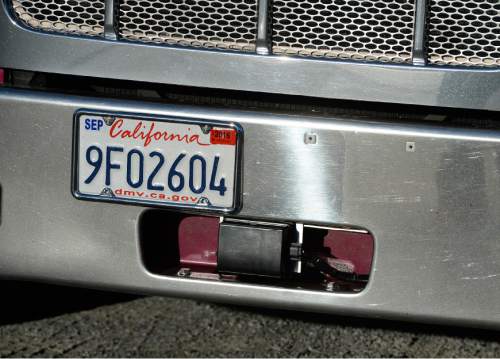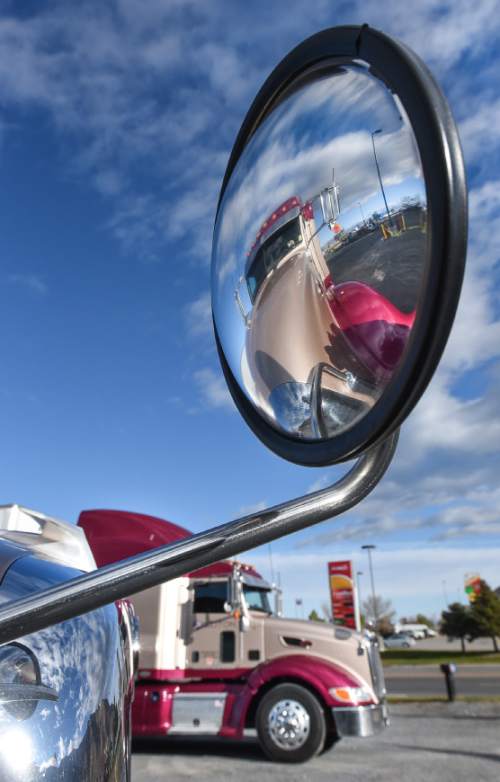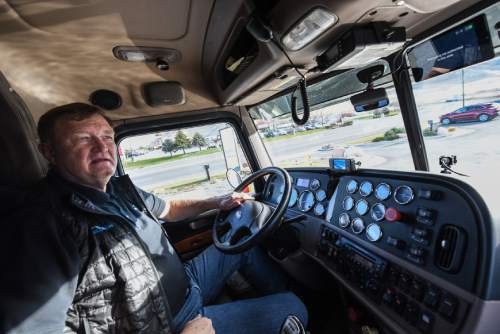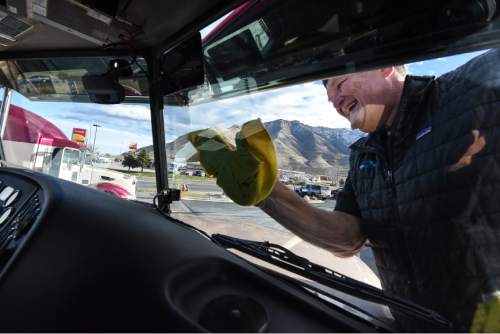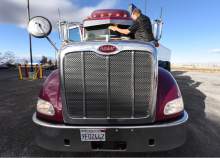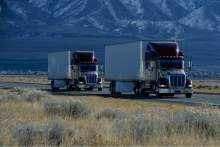This is an archived article that was published on sltrib.com in 2015, and information in the article may be outdated. It is provided only for personal research purposes and may not be reprinted.
Motorists on Utah freeways may have noticed during the past year some semitrucks tailgating oh so closely to other big rigs.
They actually were testing a new high-tech way to save fuel.
The two trucks use radio, radar, GPS, the Internet and other means to connect each other's operations, and accelerate and brake at the same time. It allows them to draft off each other.
In fact, testing on rural Utah freeways this year — allowed by special legislation — found that the rear truck in such a drafting pair saves an average of 10 percent in fuel costs, and the lead truck saves 4.5 percent.
The front truck saves fuel, too, because "there's a tremendous vortex created behind a vehicle that accounts for about a third of the drag on it. But if you pull the second vehicle in close, it destroys that vortex," said Chuck Price, vice president of Peloton, which is developing the technology.
"You see the same thing happening in NASCAR on the racetrack," he said. "Of course, they've started touching and pushing each other, which is a little beyond what we'll be doing with these trucks."
California-based Peloton and the Utah Department of Transportation offered demonstrations of the new technology for the news media Friday along Interstate 80 in Tooele County — where much of the testing occurred this year.
Steve Boyd, a co-founder and vice president of Peloton, said the technology is sort of like using cruise control, but for a couple of trucks whose operations are connected as they travel closely together to allow drafting.
"Our technology does bring trucks together closer than the normal following distance would allow," between 30 and 100 feet, depending on weather, traffic, speed and other highway conditions.
Blaine Leonard, UDOT program manager, said Utah law normally allows following no closer than two seconds behind another vehicle. So at the agency's request, Rep. John Knotwell, R-Herriman, promoteded legislation to permit such testing — as long as UDOT and the Utah Highway Patrol concurred with proposed operations.
"Eventually, I think Peloton will want to go back to the Legislature and ask to make this permanent," said Leonard, adding that current work is allowing Peloton "to gather data and let us get comfortable with the technology so that can happen."
Price said that trucks using Peloton's system are "rolling sensor platforms," collecting data about the condition of the trucks, the highway, traffic conditions, weather conditions and more to allow them to safely travel together.
For example, they have forward-facing radar that can sense obstacles — such as a car cutting off a truck — that can automatically trigger braking in connected trucks more quickly than humans could react.
Peloton has a network operating center connected by the Internet to the cloud and trucks that determines when platooning opportunities exist. It also helps connect drivers who may be near each other. The center's connection to government systems helps show when upcoming traffic is congested enough that they should stop platooning.
It helps figure which truck in a pair is able to brake more quickly — because of the weight of loads and conditions of brakes — so that vehicle always is in the rear to prevent collisions in quick-braking situations.
Drivers in a drafting pair have televisions showing the other vehicle or the other driver's view, and are in voice contact by radio. Platooning is expected to occur only on divided highways, such as interstates. The system does allow connected vehicles to pass slower vehicles together.
Boyd said fuel is the largest cost for trucking companies, accounting for 40 percent of their budget. "An individual truck in a fleet is burning over $100,000 worth of fuel per year," so "this is a big deal to save 10 percent in fuel."
He said fuel savings could pay for the cost of its system in a about a year for most companies The system also reduces emissions by burning less fuel.
Most testing will move to Texas next year because that is where the trucking fleets participating are located, but some future work is expected in Utah.



